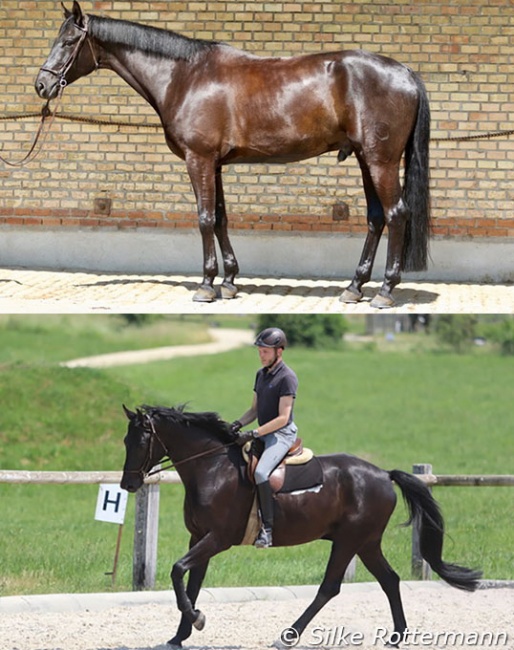
By Max Jaquerod and Silke Rottermann
In the summer of 2021 I got to know a young man during one of my stays in Switzerland whose exemplary seat and position and refined riding were out of the ordinary. Former Swiss I-judge and long-time head of the Swiss Cavalry School (EMPFA) in Berne, Pierre-Eric Jaquerod, then introduced him as his grand-son Max, a medical doctor and passionate dressage rider.
Dedicated to the great tradition of classical dressage which the former EMPFA once represented up to Olympic glory, Max follows a rather unusual path. Clearly intellectually stamped and formed as a rider from early childhood on by his now 87-year-young grand-father, he puts classical dressage principles without any compromises first. And those principles which determined the High School riding of the EMPFA are a successful symbiosis of three different schools of equitation: The French, the German and the Austrian one Therefore it is the schooling after traded principles which fascinates Max the most and it is his goal to train his horse to the highest possible level without compromising the horse’s mental and physical health.
But at the same time he considers it important not to hide at home, but contest at dressage shows and see how his work gets acknowledged.
When Max’ 7-year-old mare developed an idiopathic string-halt and had to stop advanced dressage work, he was forced to look for another equine partner and found him at a place not many would look for a dressage prospect: The Swiss Army. As riding officer of his country’s militia army Max was allowed to look for a successor of his mare there.
To follow a younger horse’s schooling from almost the beginning to the higher levels, to celebrate progress and suffer setbacks, is not only fascinating, but might be very educational. So while I observed Max trying out the 6-year-old Swiss warmblood gelding ‚Fantastico‘ at the army stables at the end of May 2023 and getting interested in this horse, the idea arose to document his future training as a series for Eurodressage, paying visits about every few weeks.
Here is the first part of hopefully more to follow. The photos were all taken during one of the first trainings of the new pair together, at the beginning of June 2023.
Will he one day live up to his name? - Fantastico
Fantastico is a Swiss warmblood, bred by Klaus and Verena Zimmermann, with a clear focus on dressage. His sire Frascino (by Fürst Heinrich x Don Frederico) carries the blood of legends like Florestan I and Donnerhall. His dam Helvetia von Buchmatt is by the Gribaldi-son Hofrat out of a dam by Dancier x Wolkenstein II. Born in 2017, Fantastico joined the Swiss Army Stables in Schönbühl near Berne in 2021.
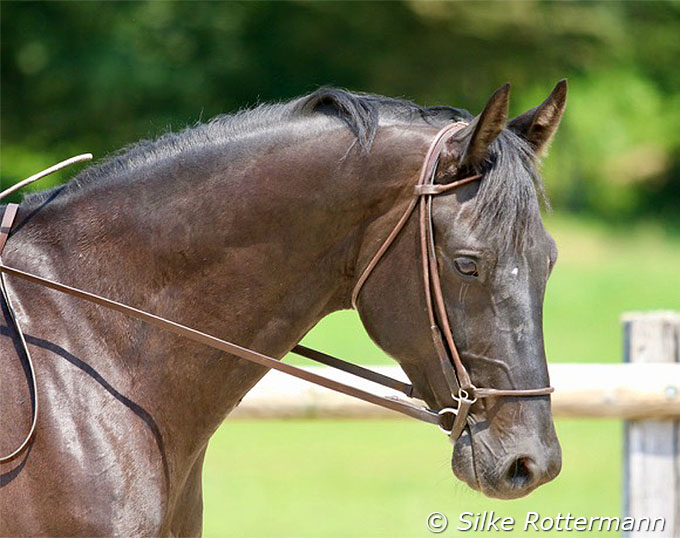
mind needs to be relaxed and
interested, but at the
same time good training reinforces these attributes
When Max Jaquerod bought the 6-year-old in the late spring of 2023 with the clear aim of training him to become a dressage horse, he got a reliable young horse with nice gaits who had already seen much, but was logically behind in his dressage training compared to identically aged horses destined for a dressage career from their early training on. This shows in several things, but over all in his degree of balance which is currently still quite horizontal compared to his peers
Jaquerod feels no need to rush though, but tackle the "construction zones" with consistency, patience and following classical principles. Training a young horse is like building a house: The basics need to be well done, so to focus on and confirm the essential basics are top priority in Fantastico’s training over the next months.
What to Focus On
Fantastico has seen and experienced many different things during his time in the army and he knows simple dressage work. A few basics he is not yet enough confirmed in and on which we are going to work on the next weeks. While the Swiss gelding has proper, but no spectacular gaits, his extraordinary character helps enormously in his daily schooling. He is very level headed, interested in learning, and extremely willing to work and cooperate.
It will be interesting to see how far we can get in our common journey and where we will find our limits.
The lateral and diagonal aids
Fantastico does not yet know the lateral aids enough which are the preconditions of the diagonal aids which lead to bending. If I act with the right rein, and the right leg, I want him to yield to this leg and this is something he has to learn now in the course of his schooling.

and allow the horse to chew comfortably. If it is cranked,
it will might hide mouth problems more or less, but reinforce them
in the end which then affects all schooling
During the schooling of a young horse I follow the principle that everything new or difficult for the horse is first getting taught in walk until the horse has understood and internalized the procedures, before I continue with it in trot. If the exercises are well confirmed in walk and trot, I finally do them in canter. Usually this system to confirm exercises and movements first in walk and then in trot takes care that a horse finally learns it in canter quite easily. It also prevents over-facing a young horse and therefore disturbing resistances.
The correct half halt
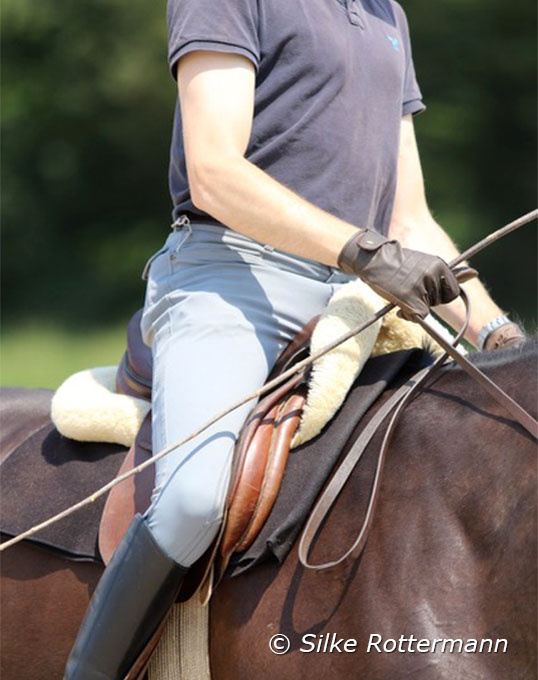
freedom of movement of the rider
This is something very essential to internalize for a horse because only then it will be possible to achieve true self-carriage with increasing collection later on.
Regarding all aids it is important and we have to have in the back of our minds that they need to be simple and clear when making a young horse acquainted to them. Simplicity and clearness allow the horse to easily do the right thing and as a consequence we do not need to use force. Once the horse is used to an aid, it usually does not take a lot of time and we can reduce the aid to a minimum. For example you will see me ride on some photos here from the beginning of our time together (June 2023) with a wider hold of reins than we want to see in classical equitation for exactly the reason that I had to make Fantastico understood what I wanted of him in a simple clear way.
In general the bigger goal is to improve my horse’s straightness and balance so we can start preparing collection.
A Training Session
If I school a young horse or if I train an advanced one, there are three ideals which my grand-father instilled in me and which I always pay attention to:
- The poll has the be the highest point (except stretching)
- the nose at least a touch in front of the vertical
- the horse has to yield in the mouth, not the poll.
These three requirements are the golden thread that should always be existent in our work.
Some people mix the poll the highest point up with the high elevation of the neck which is not suitable for young horses. But the poll at the highest point says nothing about the length of a horse’s neck.
The Warm-Up
For Fantastico’s training it is very helpful and convenient for me as his rider that he is a horse that warms up really well, has a great attitude and takes by himself a proper working tempo.
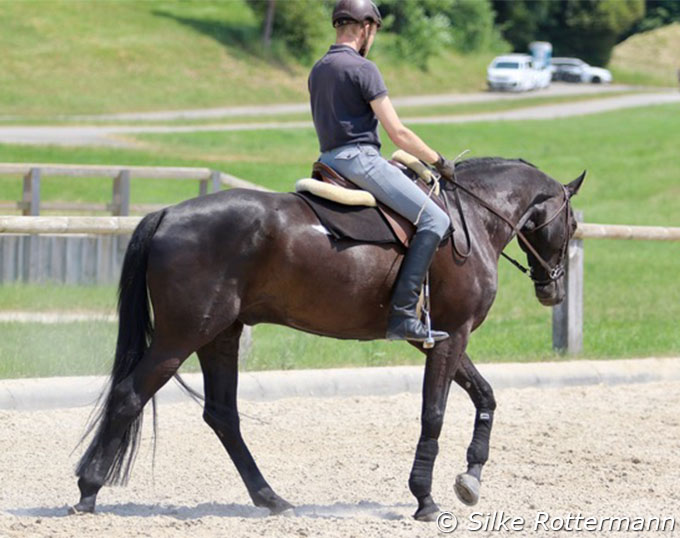
phase of walk, but not all on a long or even free rein.
Here Fantastico follows his rider’s hands forward-downward
on a circle-line which helps with the task
These exercises are very beneficial for the horse’s throughness and balance because there is a constant change of flexion, bend and direction of shift. With an inexperienced horse like Fantastico the preparation phase for these exercises is still longer, but it is crucial to prepare them meticulously because when I ask him to execute the exercises, he needs to do them without resistance. Without resistance means without a change of rhythm, in relaxation and with a soft contact. These are the ingredients which are determining the quality of work and should be our guides.
Additionally this yielding work takes care that the lateral aids are further confirmed. Fantastico bends well to the inside leg after having learnt to yield to it and my inside hand flexes him without him falling on his shoulder.
If he yields well to my leg, I may also ask a big turn on the hindquarters. This turn can later be refined to a turn in travers position which in turn can be refined to a pirouette. So these exercises have a certain purpose in the horse’s recent training, but at the same time prepare it for the next steps which explains why they need to be taught and exercised as correctly as possible before continuing in a young horse’s schooling.
Head-In
When I start trotting I often start with something called „head-in“. This is a useful exercise, not very well-known anymore, which prepares the shoulder-in and improves suppleness. I ask a working tempo and put the horse’s head to the inside with my inside rein, while the inside leg keeps the horse on the track. The outside leg takes care that the croup remains there as well.
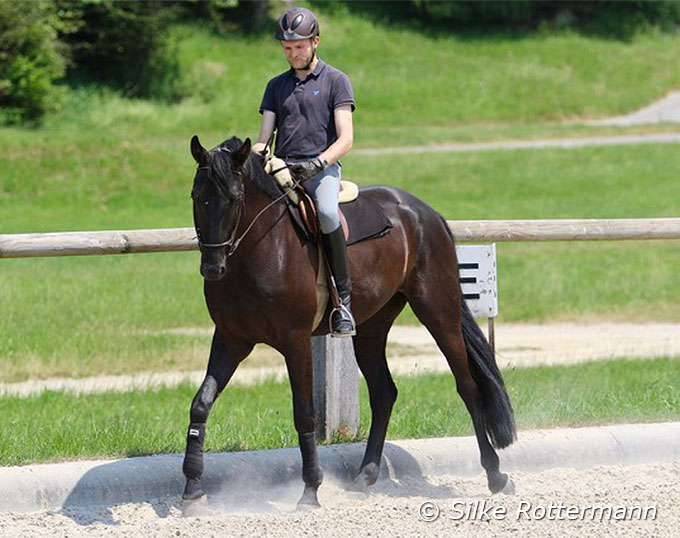
the first steps of shoulder-in which is initiated then by
a slight shift of the horse’s outside shoulder to inside
Once the horse learns to bend head and neck to the inside and at the same time continues to go forward (without falling onto his outside shoulder), his balance improves. With an advanced horse in a good balance I can still use the exercise in the warm-up to stretch the outside part of his body. But I can also use the positive effect of this exercise to develop a shoulder-in in a young horse. Then I simply ask a slight flexion to the inside and only need to position the outside shoulder a bit to the inside via my outside hand and my seat.
The flexion I obtain through the head-in-exercise can be continued with a small volte through a corner which can be diminished to a big trot pirouette. In principle this means that the trot of the horse in slight flexion gets shortened without a change in rhythm until he starts turning around his hindquarters.
Different Tempi
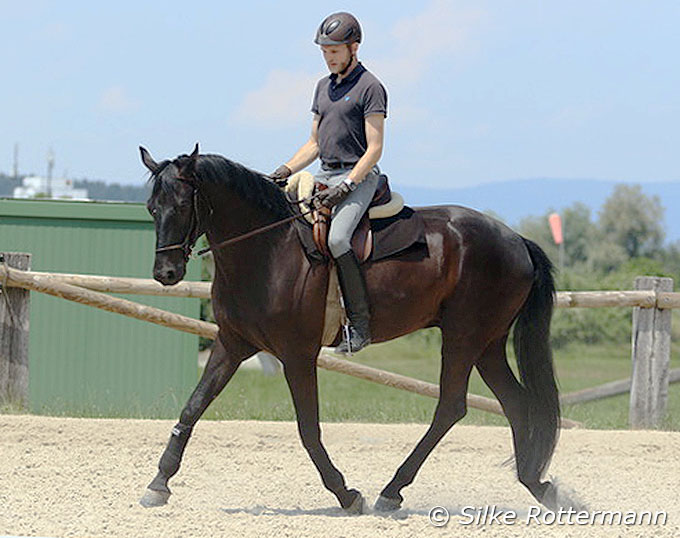
understanding and prevent applying strength. Here
Max carries his hand wider than the classical ideal to make
Fantastico understand. The need to improve the gelding’s
balance is still visible in his footfalls
To achieve this it is paramount that the young horse is supple and the rider acts carefully and relaxed. Otherwise there is the danger the horse looses the rhythm and the steps get more hasty which is the opposite of what is aimed. From the corner I go onto a circle which circumference I then vary. This exercise has several advantages: The smaller the circumference the more bend I have to ask for, this means that if the horse keeps the rhythm, the inside hind-leg has to steps increasingly forward. It also fosters the straightening of the young horse because the smaller the volte, the more the hind-legs have to follow in the tracks of the front-legs. This something totally essential, essential for straightening and therefore for collection.
Transitions
I do many transitions from walk to trot and vice versa and during them keep the horse in a slight longitudinal flexion: With the inside rein remaining very light and the outside rein guarding. The inside leg initiates a light yielding and takes care that the horse goes forward, the outside rein prevents the horse to really yield. When I start trotting I do not yield with the outside rein. With a really young horse I yield because I do not want to contradict what my legs have initiated. But Fantastico has now learned to trot through the outside rein, an expression I took over from a former cavalry rider. It means that the horse does not resist the aid at the outside rein. So the horse remains in exactly the same attitude and that slightly increases the collection because it remains the rhythm, but reduces the distance traveled by an increased hind-leg activity and lifting of the shoulders. That way the horse collects himself.
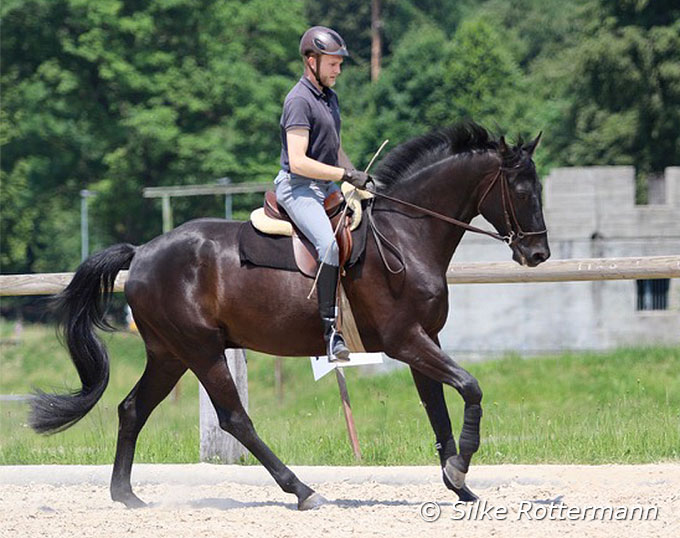
to left Max regularly renews the canter aid with his
inside leg and supports him with the outside leg
In the canter Fantastico clearly prefers the left lead at the moment. And because a simple flying change is something which is easy for him, he occasionally tries to change the lead when I canter on the right one. To prevent him doing this I take great care to constantly renew the canter aid with my inside leg and at the same time support him with the outside one. I change from circle to straight lines where I ask for this slight shoulder-fore again. It is important again to support Fantastico here with the outside leg to prevent him changing the lead.
In principle it is important to vary a lot and execute lead changes regularly and often to not tire the young horse and to keep it interested in his work.
To Show or not to Show?
I started riding Fantastico twice a week at the Military Stables from May 2023 on to find out if he is the horse I was looking for after my mare had to retire from advanced dressage work. In July, after having bought him, he moved to the National Horse Center (NPZ, former Swiss Cavalry School) where I used to have my previous horse.
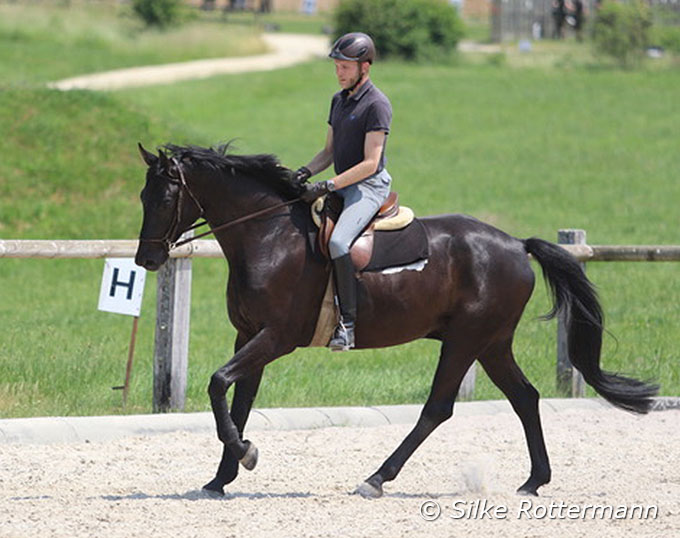
mainly consists of changing between bend lines
on bigger circles and on straight lines
along the fence
My goal was not the competition result. I am fully aware the horse still needs more training and our partnership further refinement to be really competitive. My goal was to give my green horse ring experience and to see how he handles the atmosphere at a show.
I have to say that I am really happy with how Fantastico showed. He was super obedient, relaxed and calm and even placed in a rather big field of almost 40 horses.
By Max Jaquerod with Silke Rottermann - Photos by Silke Rottermann.
Coming up next: Two months further - Fantastico’s work in late August 2023 - Part II: "The Rider Must Control Himself Before He Can Control His Horse"
Related Links
More Training and Classical Dressage Articles on Eurodressage
Pierre-Eric Jaquerod: Dressage Now Needs to be a Spectacle Instead of a Presentation of Expert Knowledge
Pierre-Eric Jaquerod: "Swiss Dressage Has Not Woken Up in Time for Transition"
World Championships Berne 1966 Through The Eyes Of…
The History of the Shoulder-In
"Welcome to the Circus" - A New Series on Classical Dressage and the Circus